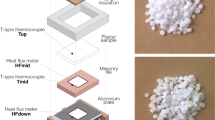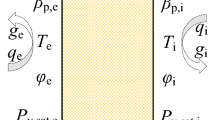Abstract
experimental conditions, experimentations on a bio-based PCM are performed with varying heat transfer rates and different configurations (PCM samples and PCM-equipped walls). Enthalpy–temperature or specific heat–temperature curves are computed for each case using an inverse method. A comparison between the results obtained with different methods and different heat transfer rates shows significant differences. The phase change temperature range obtained with the inverse method applied to the PCM samples is larger than the range obtained with the DSC test. The tests on the PCM-equipped walls show that varying heat transfer rates has a significant impact on the phase change temperature range and the hysteresis between heating and cooling curves. Higher rates increase the hysteresis and shift the phase change temperature range towards colder temperatures. Given the observed differences between properties obtained from different experimental conditions, it is recommended to carefully select the method used to define PCM enthalpy–temperature curves, taking into account the modeling application (PCM configuration and expected heating / cooling rates).
Similar content being viewed by others
References
Atchonouglo K, Banna M, Vallée C, Dupré J-C (2008). Inverse transient heat conduction problems and identification of thermal parameters. Heat and Mass Transfer, 45: 23–29.
Baetens R, Jelle BP, Gustavsen A (2010). Phase change materials for building applications: A state-of-the-art review. Energy and Buildings, 42: 1361–1368.
Bergman TL, Lavine AS, Incropera FP, De Witt DP (2011). Fundamentals of Heat and Mass Transfer, 7th edn. Hoboken, NJ, USA: John Wiley & Sons.
Braun JE, Chaturvedi N (2002). An inverse gray-box model for transient building load prediction. HVAC&R Research, 8: 73–99.
Castell A, Medrano M, Castellón C, Cabeza LF (2009). Analysis of the simulation models for the use of PCM in buildings. In: Proceedings of International Effstock: Thermal Energy Storage for Efficiency and Sustainability. Stockholm, Sweden.
Cheng R, Pomianowski M, Wang X, Heiselberg P, Zhang Y (2013). A new method to determine thermophysical properties of PCMconcrete brick. Applied Energy, 112: 988–998.
Crawley DB, Lawrie LK, Winkelmann FC, Buhl WF, Huang YJ, et al. (2001). EnergyPlus: Creating a new-generation building energy simulation program. Energy and Buildings, 33: 319–331.
Delcroix B, Kummert M, Daoud A, Bouchard J (2014). Experimental assessment of a phase change material in walls for heating and cooling applications. In: Proceedings of eSim, Ottawa, Canada.
Dentel A, Stephan W (2010). Thermal comfort in rooms with active PCM constructions. In: Proceedings of 8th International Conference on System Simulation in Buildings, Liège, Belgium.
Energy Systems Research Unit (1998). ESP-r User Guide: The ESP-r System for Building Energy Simulation. University of Strathclyde, Glasgow, UK.
German Institute for Quality Assurance and Certification (2009). Phase Change Material. Berlin, Germany.
Goodrich LE (1978). Efficient numerical technique for one-dimensional thermal problems with phase-change. International Journal of Heat and Mass Transfer, 21: 615–621.
Günther E, Hiebler S, Mehling H, Redlich R (2009). Enthalpy of phase change materials as a function of temperature: Required accuracy and suitable measurement methods. International Journal of Thermophysics, 30: 1257–1269.
Günther E, Mehling H, Hiebler S (2007). Modeling of subcooling and solidification of phase change materials. Modelling and Simulation in Materials Science and Engineering, 15: 879–892.
Heim D, Clarke JA (2004). Numerical modelling and thermal simulation of PCM–gypsum composites with ESP-r. Energy and Buildings, 36: 795–805.
Huang C-H, Jan-Yuan Y (1995). An inverse problem in simultaneously measuring temperature-dependent thermal conductivity and heat capacity. International Journal of Heat and Mass Transfer, 38: 3433–3441.
Ibánez M, Lázaro A, Zalba B, Cabeza LF (2005). An approach to the simulation of PCMs in building applications using TRNSYS. Applied Thermal Engineering, 25, 1796–1807.
Klein SA, Beckman WA, Mitchell JW, Duffie JA, Duffie NA, Freeman TL (2010). TRNSYS 17: A Transient System Simulation Program. Madison, USA: Solar Energy Laboratory, University of Wisconsin. Available at http://sel.me.wisc.edu/trnsys.
Kosny J, Stovall TK, Shrestha SS, Yarbrough DW (2010). Theoretical and experimental thermal performance analysis of complex thermal storage membrane containing bio-based phase-change material (PCM). In: Proceedings of XI International Conference on Thermal Performance of the Exterior Envelopes of Whole Buildings, Clearwater Beach, FL, USA.
Kula LW, Yovanovich MM (1991). Characteristic length of complex bodies for transient conduction. In: Proceedings of ASME Thermal Engineering Conference, vol. 1, pp. 259–267.
Kuznik F, Virgone J (2009). Experimental investigation of wallboard containing phase change material: Data for validation of numerical modeling. Energy and Buildings, 41: 561–570.
Kuznik F, Virgone J, Johannes K (2010). Development and validation of a new TRNSYS type for the simulation of external building walls containing PCM. Energy and Buildings, 42: 1004–1009.
Lawrence Berkeley National Laboratory (2013). THERM 6.3 / WINDOW 6.3—NFRC Simulation Manual.
Mehling H, Cabeza LF (2008). Heat and Cold Storage with PCM: An up to Date Introduction into Basics and Applications. Berlin: Springer.
Pedersen CO (2007). Advanced zone simulation in EnergyPlus: Incorporation of variable properties and phase change material (PCM) capability. In: Proceedings of 10th IBPSA International Conference, Beijing, China, pp. 1341–1345.
Phase Change Energy Solutions (2008). BioPCM longevity cycle testing. Available at http://www.phasechange.com/index.php/en/contractor-library.
Poulad ME, Fung AS, Naylor D (2011). Effects of convective heat transfer coefficient on the ability of PCM to reduce building energy demand. In: Proceedings of 12th IBPSA International Conference, Sydney, Australia, pp. 270–277.
Recktenwald GW (2011). Finite-Difference Approximations to the Heat Equation (Vol. 0). Portland, OR, USA. Available at http://www.f.kth.se/~jjalap/numme/FDheat.pdf.
Schranzhofer H, Puschnig P, Heinz A, Streicher W (2006). Validation of a TRNSYS simulation model for PCM energy storages and PCM wall construction elements. In: Proceedings of 10th International Conference on Thermal Energy Storage, Pomona, NJ, USA.
Sharma A, Tyagi VV, Chen CR, Buddhi D (2009). Review on thermal energy storage with phase change materials and applications. Renewable and Sustainable Energy Reviews, 13: 318–345.
Shrestha S, Miller W, Stovall T, Desjarlais A, Childs K, Porter W, Coley S (2011). Modeling PCM-enhanced insulation system and benchmarking EnergyPlus against controlled field data. In: Proceedings of 12th IBPSA International Conference, Sydney, Australia, pp. 800–807
Solé A, Miró L, Barreneche C, Martorell I, Cabeza LF (2013). Review of the T-history method to determine thermophysical properties of phase change materials (PCM). Renewable and Sustainable Energy Reviews, 26: 425–436.
Spakovszki ZS (2014). Radiation heat transfer between planar surfaces. Available at http://web.mit.edu/16.unified/www/FALL/thermodynamics/notes/node136.html. Accessed Feb. 25, 2015.
Tabares-Velasco PC, Christensen C, Bianchi M (2012). Verification and validation of EnergyPlus phase change material model for opaque wall assemblies. Building and Environment, 54: 186–196.
Math Works (2014). GA—Find minimum of function using genetic algorithm. The MathWorks Inc. Available at http://www.mathworks.com/help/gads/ga.html. Accessed Jul. 2, 2014.
Voller V R, Cross M (1981). Accurate solutions of moving boundary problems using the enthalpy method. International Journal of Heat and Mass Transfer, 24: 545–556.
Yao M, Chait A (1993). An alternative formulation of the apparent heat capacity method for phase change problems. Numerical Heat Transfer, Part B: Fundamentals, 24: 279–300.
Zalba B, Marín JM, Cabeza LF, Mehling H (2003). Review on thermal energy storage with phase change: materials, heat transfer analysis and applications. Applied Thermal Engineering, 23: 251–283.
Author information
Authors and Affiliations
Corresponding author
Rights and permissions
About this article
Cite this article
Delcroix, B., Kummert, M., Daoud, A. et al. Influence of experimental conditions on measured thermal properties used to model phase change materials. Build. Simul. 8, 637–650 (2015). https://doi.org/10.1007/s12273-015-0241-8
Received:
Revised:
Accepted:
Published:
Issue Date:
DOI: https://doi.org/10.1007/s12273-015-0241-8




